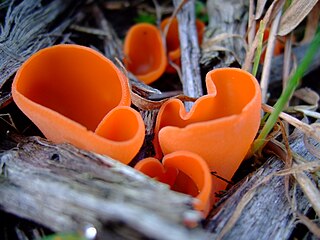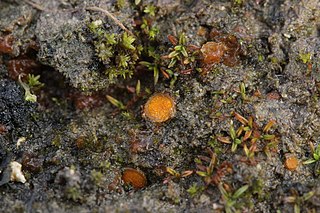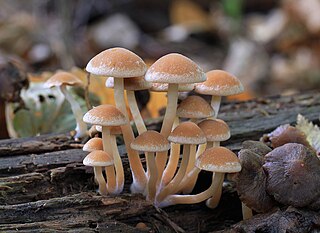
The Carboniferous is a geologic period and system of the Paleozoic that spans 60 million years from the end of the Devonian Period 358.9 Ma, to the beginning of the Permian Period, 298.9 Ma. In North America, the Carboniferous is often treated as two separate geological periods, the earlier Mississippian and the later Pennsylvanian.

Coprinellus is a genus of mushroom-forming fungi in the family Psathyrellaceae. The genus was circumscribed by the Finnish mycologist Petter Adolf Karsten in 1879. Most Coprinellus species were transferred from the once large genus Coprinus. Molecular studies published in 2001 redistributed Coprinus species to Psathyrella, or the segregate genera Coprinopsis and Coprinellus.

Aleuria is a genus of cup fungi within the phylum Ascomycota. The best known species is Orange peel fungus, A. aurantia.
The North Staffordshire Field Club was an organisation founded in 1865 to study the natural history, geology, industrial history, folklore and local history of North Staffordshire, England. Its establishing president from 1865-70 was industrialist and banker James Bateman FRS.

Lamprospora is a genus of fungi in the family Pyronemataceae.

Catinella is a genus of fungi in the class Dothideomycetes. It is placed in the monotypic family of Catinellaceae in the monotypic order of Catinellales.

Rutstroemia is a genus of fungi in the family Rutstroemiaceae. It was circumscribed by Petter Karsten in 1871.

Hypocenomyce is a genus of lichen-forming fungi in the family Ophioparmaceae. Species in the genus grow on bark and on wood, especially on burned tree stumps and trunks in coniferous forest. Hypocenomyce lichens are widely distributed in the northern hemisphere.

Tyromyces is a genus of poroid fungi in the family Polyporaceae. It was circumscribed by mycologist Petter Karsten in 1881. The type species is the widely distributed Tyromyces chioneus, commonly known as the white cheese polypore. The phylogenetic position of Tyromyces within the Polyporales is uncertain, but it appears that it does not belong to the "core polyporoid clade". Tyromyces is polyphyletic as it is currently circumscribed, and has been described as "a dumping place for monomitic white-rot species with thin-walled spores."

The Marros Group is the name given to a suite of rocks of Namurian age laid down during the Carboniferous Period in South Wales. These rocks were formerly known as the Millstone Grit Series but are now distinguished from the similar but geographically separate rock sequences of the Pennines and Peak District of northern England and northeast Wales by this new name.

Psathyrella piluliformis is a species of agaric fungus in the family Psathyrellaceae. It produces fruit bodies (mushrooms) with broadly convex caps measuring 2–5 cm in diameter. The caps are chestnut to reddish brown, the color fading with age and with dry weather. The closely spaced gills have an adnate attachment to the stipe. They are initially tan until the spores mature, when the gills turn dark brown. Fragments of the partial veil may remain on the cap margin, and as a wispy band of hairs on the stipe. The stipe is 2–7 cm tall and 3–7 mm wide, white, smooth, hollow, and bulging at the base. Fruiting occurs in clusters at the base of hardwood stumps.

Vernonopterus is a genus of eurypterid, a group of extinct aquatic arthropods. Fossils of Vernonopterus have been discovered in deposits of the Carboniferous period in Scotland. The name of the genus derives from the location where the only known fossil has been discovered, Mount Vernon near Airdrie in Lanarkshire, Scotland. A single species of Vernonopterus is recognized, V. minutisculptus, based on fragmentary fossilized tergites, segments on the upper side of the abdomen. The species name minutisculptus refers to the ornamentation of scales that covers the entirety of the preserved parts of the eurypterid.
Wheelton Hind was an English surgeon and geologist.

Carbonicola is a small genus of lichen-forming fungi. It is the sole genus in the monogeneric family Carbonicolaceae. The genus, which collectively has an almost cosmopolitan distribution, contains three squamulose lichens that prefer to grow on burned wood in temperate areas of the world.
Carbonicola is the genus name for two groups of organisms and may refer to:

The following outline provides an overview of and topical guide to lichens.













